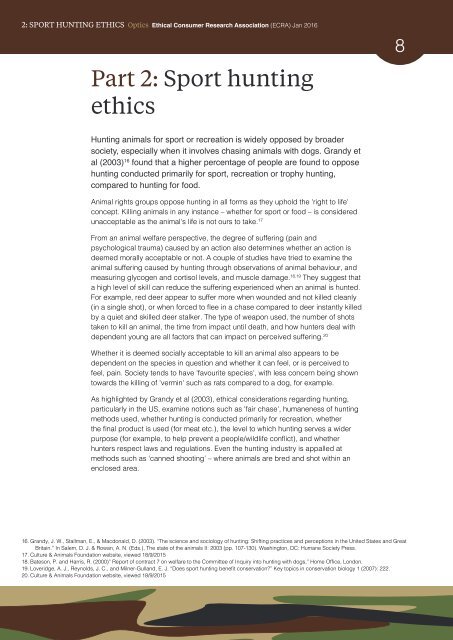Shooting Wildlife?
optics%20report
optics%20report
You also want an ePaper? Increase the reach of your titles
YUMPU automatically turns print PDFs into web optimized ePapers that Google loves.
2: SPORT HUNTING ETHICS Optics Ethical Consumer Research Association (ECRA) Jan 2016<br />
Part 2: Sport hunting<br />
ethics<br />
8<br />
Hunting animals for sport or recreation is widely opposed by broader<br />
society, especially when it involves chasing animals with dogs. Grandy et<br />
al (2003) 16 found that a higher percentage of people are found to oppose<br />
hunting conducted primarily for sport, recreation or trophy hunting,<br />
compared to hunting for food.<br />
Animal rights groups oppose hunting in all forms as they uphold the 'right to life'<br />
concept. Killing animals in any instance – whether for sport or food – is considered<br />
unacceptable as the animal's life is not ours to take. 17<br />
From an animal welfare perspective, the degree of suffering (pain and<br />
psychological trauma) caused by an action also determines whether an action is<br />
deemed morally acceptable or not. A couple of studies have tried to examine the<br />
animal suffering caused by hunting through observations of animal behaviour, and<br />
measuring glycogen and cortisol levels, and muscle damage. 18,19 They suggest that<br />
a high level of skill can reduce the suffering experienced when an animal is hunted.<br />
For example, red deer appear to suffer more when wounded and not killed cleanly<br />
(in a single shot), or when forced to flee in a chase compared to deer instantly killed<br />
by a quiet and skilled deer stalker. The type of weapon used, the number of shots<br />
taken to kill an animal, the time from impact until death, and how hunters deal with<br />
dependent young are all factors that can impact on perceived suffering. 20<br />
Whether it is deemed socially acceptable to kill an animal also appears to be<br />
dependent on the species in question and whether it can feel, or is perceived to<br />
feel, pain. Society tends to have 'favourite species', with less concern being shown<br />
towards the killing of 'vermin' such as rats compared to a dog, for example.<br />
As highlighted by Grandy et al (2003), ethical considerations regarding hunting,<br />
particularly in the US, examine notions such as 'fair chase', humaneness of hunting<br />
methods used, whether hunting is conducted primarily for recreation, whether<br />
the final product is used (for meat etc.), the level to which hunting serves a wider<br />
purpose (for example, to help prevent a people/wildlife conflict), and whether<br />
hunters respect laws and regulations. Even the hunting industry is appalled at<br />
methods such as ‘canned shooting’ – where animals are bred and shot within an<br />
enclosed area.<br />
16. Grandy, J. W., Stallman, E., & Macdonald, D. (2003). “The science and sociology of hunting: Shifting practices and perceptions in the United States and Great<br />
Britain.” In Salem, D. J. & Rowan, A. N. (Eds.), The state of the animals II: 2003 (pp. 107-130). Washington, DC: Humane Society Press.<br />
17. Culture & Animals Foundation website, viewed 18/9/2015<br />
18. Bateson, P. and Harris, R. (2000)” Report of contract 7 on welfare to the Committee of Inquiry into hunting with dogs,” Home Office, London.<br />
19. Loveridge, A. J., Reynolds, J. C., and Milner-Gulland, E. J. “Does sport hunting benefit conservation?” Key topics in conservation biology 1 (2007): 222.<br />
20. Culture & Animals Foundation website, viewed 18/9/2015


